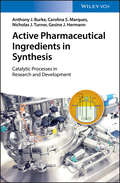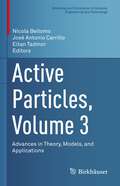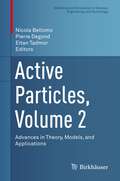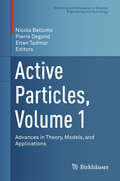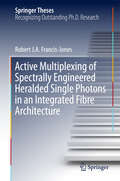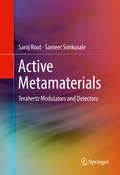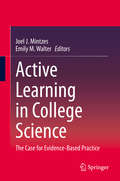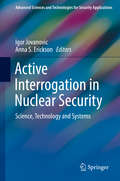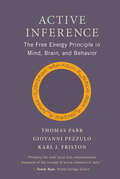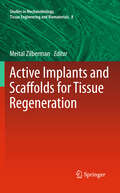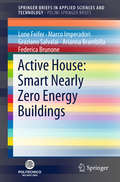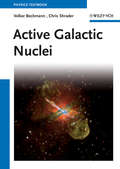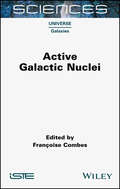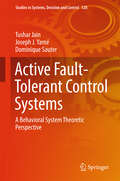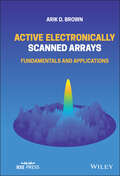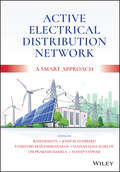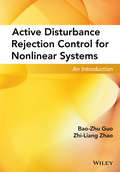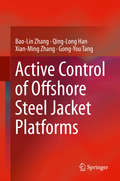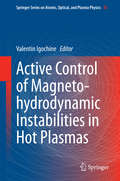- Table View
- List View
Active Physics: Medicine
by Arthur EisenkraftDr. Arthur Eisenkraft, project director, presents a short overview explaining how and why Active physics works. High School Physics Textbook.
Active Physical Science (Student Edition)
by Arthur Eisenkraft Gary FreeburyBook contains two units, Active Physics and Active Chemistry.
Active Pharmaceutical Ingredients in Synthesis: Catalytic Processes in Research and Development
by Gesine J. Hermann Nicholas J. Turner Carolina Silva Marques Anthony J. BurkePresents the most effective catalytic reactions in use today, with a special focus on process intensification, sustainability, waste reduction, and innovative methods This book demonstrates the importance of efficient catalytic transformations for producing pharmaceutically active molecules. It presents the key catalytic reactions and the most efficient catalytic processes, including their significant advantages over compared previous methods. It also places a strong emphasis on asymmetric catalytic reactions, process intensification (PI), sustainability and waste mitigation, continuous manufacturing processes as enshrined by continuous flow catalysis, and supported catalysis. Active Pharmaceutical Ingredients in Synthesis: Catalytic Processes in Research and Development offers chapters covering: Catalysis and Prerequisites for the Modern Pharmaceutial Industry Landscape; Catalytic Process Design - The Industrial Perspective; Hydrogenation, Hydroformylation and Other Reductions; Oxidation; ; Catalytic Addition Reactions; Catalytic Cross-Coupling Reactions; Catalytic Metathesis Reactions; Catalytic Cycloaddition Reactions: Coming Full-Circle; Catalytic Cyclopropanation Reactions; Catalytic C-H insertion Reactions; Phase Transfer Catalysis; and Biocatalysis. -Provides the reader with an updated clear view of the current state of the challenging field of catalysis for API production -Focuses on the application of catalytic methods for the synthesis of known APIs -Presents every key reaction, including Diels-Alder, CH Insertions, Metal-catalytic coupling-reactions, and many more -Includes recent patent literature for completeness Covering a topic of great interest for synthetic chemists and R&D researchers in the pharmaceutical industry, Active Pharmaceutical Ingredients in Synthesis: Catalytic Processes in Research and Development is a must-read for every synthetic chemist working with APIs.
Active Particles, Volume 3: Advances in Theory, Models, and Applications (Modeling and Simulation in Science, Engineering and Technology)
by Nicola Bellomo José Antonio Carrillo Eitan TadmorThis edited volume collects six surveys that present state-of-the-art results on modeling, qualitative analysis, and simulation of active matter, focusing on specific applications in the natural sciences. Following the previously published Active Particles volumes, these chapters are written by leading experts in the field and reflect the diversity of subject matter in theory and applications within an interdisciplinary framework. Topics covered include:Variability and heterogeneity in natural swarmsMultiscale aspects of the dynamics of human crowdsMathematical modeling of cell collective motion triggered by self-generated gradientsClustering dynamics on graphsRandom Batch Methods for classical and quantum interacting particle systemsThe consensus-based global optimization algorithm and its recent variantsMathematicians and other members of the scientific community interested in active matter and its many applications will find this volume to be a timely, authoritative, and valuable resource.
Active Particles, Volume 2: Advances in Theory, Models, and Applications (Modeling and Simulation in Science, Engineering and Technology)
by Nicola Bellomo Pierre Degond Eitan TadmorThis volume compiles eight recent surveys that present state-of-the-art results in the field of active matter at different scales, modeled by agent-based, kinetic, and hydrodynamic descriptions. Following the previously published volume, these chapters were written by leading experts in the field and accurately reflect the diversity of subject matter in theory and applications. Several mathematical tools are employed throughout the volume, including analysis of nonlinear PDEs, network theory, mean field approximations, control theory, and flocking analysis. The book also covers a wide range of applications, including:Biological network formationSocial systemsControl theory of sparse systemsDynamics of swarming and flocking systemsStochastic particles and mean field approximationsMathematicians and other members of the scientific community interested in active matter and its many applications will find this volume to be a timely, authoritative, and valuable resource.
Active Particles, Volume 1: Advances in Theory, Models, and Applications (Modeling and Simulation in Science, Engineering and Technology)
by Nicola Bellomo Pierre Degond Eitan TadmorThis volume collects ten surveys on the modeling, simulation, and applications of active particles using methods ranging from mathematical kinetic theory to nonequilibrium statistical mechanics. The contributing authors are leading experts working in this challenging field, and each of their chapters provides a review of the most recent results in their areas and looks ahead to future research directions. The approaches to studying active matter are presented here from many different perspectives, such as individual-based models, evolutionary games, Brownian motion, and continuum theories, as well as various combinations of these. Applications covered include biological network formation and network theory; opinion formation and social systems; control theory of sparse systems; theory and applications of mean field games; population learning; dynamics of flocking systems; vehicular traffic flow; and stochastic particles and mean field approximation. Mathematicians and other members of the scientific community interested in active matter and its many applications will find this volume to be a timely, authoritative, and valuable resource.
Active Multiplexing of Spectrally Engineered Heralded Single Photons in an Integrated Fibre Architecture (Springer Theses)
by Robert J. A. Francis-JonesThis clearly written thesis discusses the development of a highly innovative single-photon source that uses active optical switching, known as multiplexing, to increase the probability of delivering photons into a single mode. Improving single-photon sources is critical in advancing the state of the art in photonic quantum technologies for information processing and communications.
Active Metamaterials: Terahertz Modulators and Detectors
by Saroj Rout Sameer SonkusaleThis book covers the theoretical background, experimental methods and implementation details to engineer for communication and imaging application, terahertz devices using metamaterials, in mainstream semiconductor foundry processes. This book will provide engineers and physicists an authoritative reference to construct such devices with minimal background. The authors describe the design and construction of electromagnetic (EM) devices for terahertz frequencies (108-1010 cycles/sec) using artificial materials that are a fraction of the wavelength of the incident EM wave, resulting in an effective electric and magnetic properties (permittivity and permeability) that are unavailable in natural materials.
Active Learning in College Science: The Case for Evidence-Based Practice
by Joel J. Mintzes Emily M. WalterThis book explores evidence-based practice in college science teaching. It is grounded in disciplinary education research by practicing scientists who have chosen to take Wieman’s (2014) challenge seriously, and to investigate claims about the efficacy of alternative strategies in college science teaching. In editing this book, we have chosen to showcase outstanding cases of exemplary practice supported by solid evidence, and to include practitioners who offer models of teaching and learning that meet the high standards of the scientific disciplines. Our intention is to let these distinguished scientists speak for themselves and to offer authentic guidance to those who seek models of excellence. Our primary audience consists of the thousands of dedicated faculty and graduate students who teach undergraduate science at community and technical colleges, 4-year liberal arts institutions, comprehensive regional campuses, and flagship research universities. In keeping with Wieman’s challenge, our primary focus has been on identifying classroom practices that encourage and support meaningful learning and conceptual understanding in the natural sciences. The content is structured as follows: after an Introduction based on Constructivist Learning Theory (Section I), the practices we explore are Eliciting Ideas and Encouraging Reflection (Section II); Using Clickers to Engage Students (Section III); Supporting Peer Interaction through Small Group Activities (Section IV); Restructuring Curriculum and Instruction (Section V); Rethinking the Physical Environment (Section VI); Enhancing Understanding with Technology (Section VII), and Assessing Understanding (Section VIII). The book’s final section (IX) is devoted to Professional Issues facing college and university faculty who choose to adopt active learning in their courses. The common feature underlying all of the strategies described in this book is their emphasis on actively engaging students who seek to make sense of natural objects and events. Many of the strategies we highlight emerge from a constructivist view of learning that has gained widespread acceptance in recent years. In this view, learners make sense of the world by forging connections between new ideas and those that are part of their existing knowledge base. For most students, that knowledge base is riddled with a host of naïve notions, misconceptions and alternative conceptions they have acquired throughout their lives. To a considerable extent, the job of the teacher is to coax out these ideas; to help students understand how their ideas differ from the scientifically accepted view; to assist as students restructure and reconcile their newly acquired knowledge; and to provide opportunities for students to evaluate what they have learned and apply it in novel circumstances. Clearly, this prescription demands far more than most college and university scientists have been prepared for.
Active Interrogation in Nuclear Security: Science, Technology and Systems (Advanced Sciences and Technologies for Security Applications)
by Igor Jovanovic Anna S. EricksonThis volume constitutes the state-of-the-art in active interrogation, widely recognized as indispensable methods for addressing current and future nuclear security needs. Written by a leading group of science and technology experts, this comprehensive reference presents technologies and systems in the context of the fundamental physics challenges and practical requirements. It compares the features, limitations, technologies, and impact of passive and active measurement techniques; describes radiation sources for active interrogation including electron and ion accelerators, intense lasers, and radioisotope-based sources; and it describes radiation detectors used for active interrogation. Entire chapters are devoted to data acquisition and processing systems, modeling and simulation, data interpretation and algorithms, and a survey of working active measurement systems. Active Interrogation in Nuclear Security is structured to appeal to a range of audiences, including graduate students, active researchers in the field, and policy analysts.The first book devoted entirely to active interrogationPresents a focused review of the relevant physicsSurveys available technologyAnalyzes scientific and technology trends Provides historical and policy context Igor Jovanovic is a Professor of Nuclear Engineering and Radiological Sciences at the University of Michigan and has previously also taught at Penn State University and Purdue University. He received his Ph.D. from University of California, Berkeley and worked as physicist at Lawrence Livermore National Laboratory. Dr. Jovanovic has made numerous contributions to the science and technology of radiation detection, as well as the radiation sources for use in active interrogation in nuclear security. He has taught numerous undergraduate and graduate courses in areas that include radiation detection, nuclear physics, and nuclear security. At University of Michigan Dr. Jovanovic is the director of Neutron Science Laboratory and is also associated with the Center for Ultrafast Optical Science. Anna Erickson is an Assistant Professor in the Nuclear and Radiological Engineering Program of the G.W. Woodruff School of Mechanical Engineering at Georgia Institute of Technology. Previously, she was a postdoctoral researcher in the Advanced Detectors Group at Lawrence Livermore National Laboratory. Dr. Erickson received her PhD from Massachusetts Institute of Technology with a focus on radiation detection for active interrogation applications. Her research interests focus on nuclear non-proliferation including antineutrino analysis and non-traditional detector design and characterization. She teaches courses in advanced experimental detection for reactor and nuclear nonproliferation applications, radiation dosimetry and fast reactor analysis.
Active Inference: The Free Energy Principle in Mind, Brain, and Behavior
by Thomas Parr Karl J. Friston Giovanni PezzuloThe first comprehensive treatment of active inference, an integrative perspective on brain, cognition, and behavior used across multiple disciplines. Active inference is a way of understanding sentient behavior—a theory that characterizes perception, planning, and action in terms of probabilistic inference. Developed by theoretical neuroscientist Karl Friston over years of groundbreaking research, active inference provides an integrated perspective on brain, cognition, and behavior that is increasingly used across multiple disciplines including neuroscience, psychology, and philosophy. Active inference puts the action into perception. This book offers the first comprehensive treatment of active inference, covering theory, applications, and cognitive domains. Active inference is a &“first principles&” approach to understanding behavior and the brain, framed in terms of a single imperative to minimize free energy. The book emphasizes the implications of the free energy principle for understanding how the brain works. It first introduces active inference both conceptually and formally, contextualizing it within current theories of cognition. It then provides specific examples of computational models that use active inference to explain such cognitive phenomena as perception, attention, memory, and planning.
Active Implants and Scaffolds for Tissue Regeneration (Studies in Mechanobiology, Tissue Engineering and Biomaterials #8)
by Meital ZilbermanActive implants are actually drug or protein-eluting implants that induce healing effects, in addition to their regular task, such as support. This effect is achieved by controlled release of the active agent to the surrounding tissue. This book will give a broad overview of biomaterial platforms used as basic elements of drug-eluting implants. It will include mainly coatings for vascular stents with controlled release of antiproliferative agents, wound dressings with controlled release of antibacterial agents, drug-eluting vascular grafts, protein-eluting scaffolds for tissue regeneration, drug-eluting platforms for dental and other applications. Thus, both internal and external implants are described. The drug-eluting implants will be described in terms of matrix formats and polymers, incorporated drugs and their release profiles from the implants, as well as implant functioning. Smart polymeric systems, such as crosslinked poly-lactones, thermo and pH-sensitive hydrogels and poly(amido-amines), as well as novel basic structural elements, such as composite fibers and films, and nanostructures will be thoroughly described. The effect of the processing parameters on the microstructure and on the resulting drug release profiles, mechanical and physical properties, and other relevant properties, will be emphasized. The described new biomaterials approaches for active implants enhance the tools available for creating clinically important biomedical applications.
Active House: Smart Nearly Zero Energy Buildings (SpringerBriefs in Applied Sciences and Technology)
by Lone Feifer Marco Imperadori Graziano Salvalai Arianna Brambilla Federica BrunoneThe book provides an overview of the Active House (AH) vision, intended as a building design method “beyond” the passive approach for buildings of the future that will be more and more connected, smart and innovative. It offers a novel philosophical design approach in which buildings, new or renovated, are in balance with natural, renewable energies and become “concentrators-distributors” of energies instead of being consumers of resources. The book is composed of five chapters, providing information on fundamental aspects of innovations toward resource-efficient buildings, as well as case studies presenting the concept in practice. It demonstrates that a completely new design approach is possible, and that a turning point has been reached. Lastly, it shows how the AH Alliance, along with designers, institutions, industries and academies, is bringing a breath of fresh air to the world of construction.
Active Galactic Nuclei
by Volker Beckmann Chris ShraderActive Galactic Nuclei This AGN textbook gives an overview on the current knowledge of the Active Galacitc Nuclei phenomenon. The spectral energy distribution will be discussed, pointing out what can be observed in different wavebands. The different physical models are presented together with formula important for the understanding of AGN physics. Furthermore, the authors discuss the AGN with respect to its environment, host galaxy, feedback in galaxies and in clusters of galaxies, variability, etc. and finally the cosmological evolution of the AGN phenomenon. This book includes phenomena based on new results in the X-Ray and gamma-ray domain from new telescopes such as Chandra, XMM-Newton, the Fermi Gamma-Ray Space Telescope, and the VHE regime not mentioned so far in AGN books. Those and other new developments as well as simulations of AGN merging events and formations, enabled through latest super-computing capabilities. From the contents: The observational picture of AGN Radiative processes The central engine AGN types and unification AGN through the electromagnetic spectrum AGN variability Environment Quasars and cosmology Formation, evolution and the ultimate fate of AGN What we do not know (yet)
Active Galactic Nuclei
by Françoise CombesAll galaxies host a super-massive black hole in their center. These black holes grow their mass in symbiosis with their host galaxy and moderate their star formation. When matter is driven towards the nucleus, an accretion disk is formed to transfer angular momentum and considerable energy is released when the material falls into the black hole: this is the phenomenon of active galactic nuclei (AGN). A nucleus can shine one thousand times more brightly than the entire galaxy with its 200 billion stars. The nuclear activity can take many forms, from very powerful quasars to more ordinary Seyfert galaxies, passing by radio-galaxies, which eject a collimated plasma at ten times the radius of the galaxy.This book examines all of these manifestations and presents a unified view. When two galaxies merge, a binary black hole is formed and the two black holes will spiral inwards and merge, emitting long gravitational waves, which could be detected by the future LISA satellite.
Active Fault-Tolerant Control Systems: A Behavioral System Theoretic Perspective (Studies in Systems, Decision and Control #128)
by Tushar Jain Joseph J. Yamé Dominique SauterThe book introduces novel algorithms for designing fault-tolerant control (FTC) systems using the behavioral system theoretic approach, and presents a demonstration of successful novel FTC mechanisms on several benchmark examples. The authors also discuss a new transient management scheme, which is an essential requirement for the implementation of active FTC systems, and two data-driven methodologies that are broadly classified as active FTC systems: the projection-based approach and the online-redesign approach. These algorithms do not require much a priori information about the plant in real-time, and in addition this novel implementation of active FTC systems circumvents various weaknesses induced by using a diagnostic module in real-time. The book provides graduate students taking masters and doctoral courses in mathematics, control, and electrical engineering an excellent stepping-stone for their research. It also appeals to practitioners interested to apply innovative fail-safe control techniques.
Active Electronically Scanned Arrays: Fundamentals and Applications (IEEE Press)
by Arik D. BrownIn Active Electronically Scanned Arrays: Fundamentals and Applications, electromagnetics expert Dr. Arik D. Brown delivers a foundational treatment of active electronically scanned arrays (AESAs) ideal for engineering students and professionals. The distinguished author provides an overview of the primary subsystems of an AESA and detailed explanations of key design concepts and fundamentals for subsystems, including antenna array elements, transmit/receive modules, and beamformers. Performance results for various AESA architectures often found in industry, including analog, subarrayed, and digital beamforming AESAs, are discussed. With a focus on practical knowledge and applications, Active Electronically Scanned Arrays: Fundamentals and Applications offers an accessible overview of a technology critical to the implementation of collision avoidance in cars, air surveillance radar, communication antennas, and defense technologies. The book also includes: A thorough introduction to AESAs, including a top-level block diagram view and explanations of key components and subsystems Detailed explanations of the impact of AESAs on mission applications including Radar, Electronic Attack (EA), Electronic Support Measures (ESM), SIGINT and Communications Comprehensive explorations of antenna array elements, transmit/receive modules, and beamformers including their purpose, functions, and practical design considerations In-depth examinations of AESA architecture performance for current and future systems Utility of AESAs for implementing adaptive beamforming for Electronic Counter-Countermeasures (ECCM) Perfect for electrical engineers working with active electronically scanned arrays, electronic warfare technologies, radar, or communications, Active Electronically Scanned Arrays: Fundamentals and Applications will also prove to be an invaluable resource for defense students undertaking military education and training.
Active Electrical Distribution Network: A Smart Approach
by Baseem Khan Josep M. Guerrero Sanjeevikumar Padmanaban Hassan Haes Alhelou Om Prakash Mahela Sudeep TanwarACTIVE ELECTRICAL DISTRIBUTION NETWORK Discover the major issues, solutions, techniques, and applications of active electrical distribution networks with this edited resourceActive Electrical Distribution Network: A Smart Approach delivers a comprehensive and insightful guide dedicated to addressing the major issues affecting an often-overlooked sector of the electrical industry: electrical distribution. The book discusses in detail a variety of challenges facing the smart electrical distribution network and presents a detailed framework to address these challenges with renewable energy integration.The book offers readers fulsome analyses of active distribution networks for smart grids, as well as active control approached for distributed generation, electric vehicle technology, smart metering systems, smart monitoring devices, smart management systems, and various storage systems. It provides a treatment of the analysis, modeling, and implementation of active electrical distribution systems and an exploration of the ways professionals and researchers from academia and industry attempt to meet the significant challenges facing them.From smart home energy management systems to approaches for the reconfiguration of active distribution networks with renewable energy integration, readers will also enjoy:A thorough introduction to electrical distribution networks, including conventional and smart networksAn exploration of various existing issues related to the electrical distribution networkAn examination of the importance of harmonics mitigation in smart distribution networks, including active filtersA treatment of reactive power compensation under smart distribution networks, including techniques like capacitor banks and smart devicesAn analysis of smart distribution network reliability assessment and enhancementPerfect for professionals, scientists, technologists, developers, designers, and researchers in smart grid technologies, security, and information technology, Active Electrical Distribution Network: A Smart Approach will also earn a place in the libraries of policy and administration professionals, as well as those involved with electric utilities, electric policy development, and regulating authorities.
Active Disturbance Rejection Control for Nonlinear Systems: An Introduction
by Bao-Zhu Guo Zhi-Liang ZhaoA concise, in-depth introduction to active disturbance rejection control theory for nonlinear systems, with numerical simulations and clearly worked out equations Provides the fundamental, theoretical foundation for applications of active disturbance rejection control Features numerical simulations and clearly worked out equations Highlights the advantages of active disturbance rejection control, including small overshooting, fast convergence, and energy savings
Active Control of Offshore Steel Jacket Platforms
by Gong-You Tang Xian-Ming Zhang Qing-Long Han Bao-Lin Zhang<p>Offshore platforms are widely used to explore, drill, produce, store and transport ocean resources, and are usually subjected to environmental loading, which can lead to deck facility failure and platform fatigue failure, inefficient operation and even crew discomfort. In order to ensure the reliability and safety of offshore platforms, it is important to explore effective ways of suppressing the vibration of offshore platforms. <p>This book provides a brief overview of passive, semi-active and active control schemes to deal with vibration of offshore platforms. It then comprehensively and systematically discusses the recent advances in active systems with optimal, sliding model, delayed feedback and network-based control. Intended for readers interested in vibration control and ocean engineering, it is particularly useful for researchers, engineers, and graduate students in the fields of system and control community, vibration control, ocean engineering, as well as electrical and electronic engineering.</p>
Active Control of Magneto-hydrodynamic Instabilities in Hot Plasmas (Springer Series on Atomic, Optical, and Plasma Physics #83)
by Valentin IgochineDuring the past century, world-wide energy consumption has risen dramatically, which leads to a quest for new energy sources. Fusion of hydrogen atoms in hot plasmas is an attractive approach to solve the energy problem, with abundant fuel, inherent safety and no long-lived radioactivity. However, one of the limits on plasma performance is due to the various classes of magneto-hydrodynamic instabilities that may occur. The physics and control of these instabilities in modern magnetic confinement fusion devices is the subject of this book. Written by foremost experts, the contributions will provide valuable reference and up-to-date research reviews for "old hands" and newcomers alike.
Active Chemistry
by Arthur EisenkraftThe highlighting features of this Chemistry text book are: Scenario, Chapter Challenge, Criteria, What Do You Think?, Investigate, Chem Talk, Chem Words, Checking Up, Reflecting on the Activity and the Challenge, Chemistry to Go, Preparing for the Chapter Challenge, Challenge Assessment, Chemistry at Work and Photos and Illustrations.


